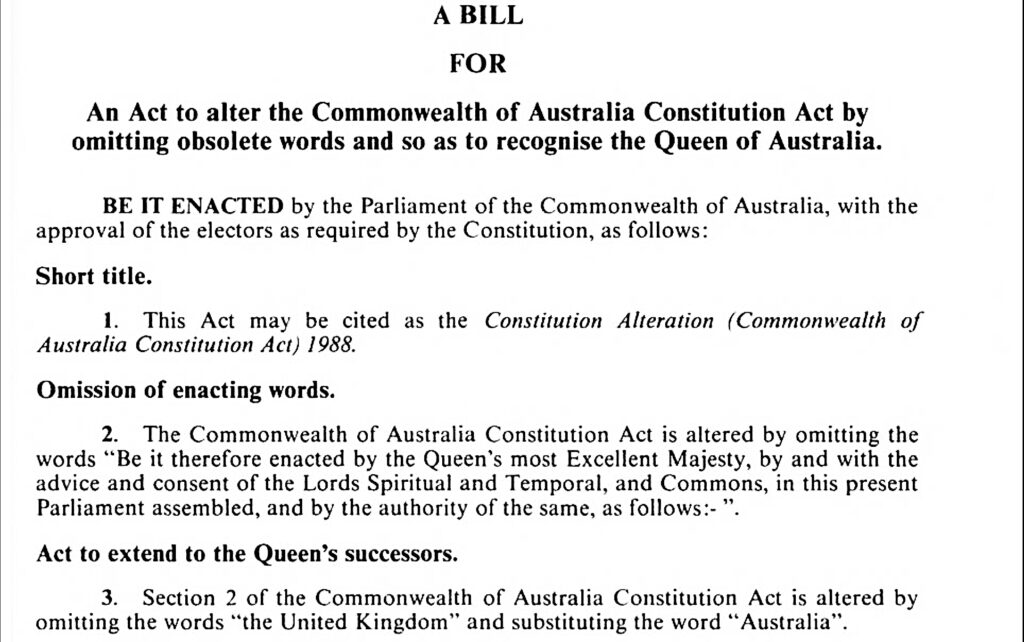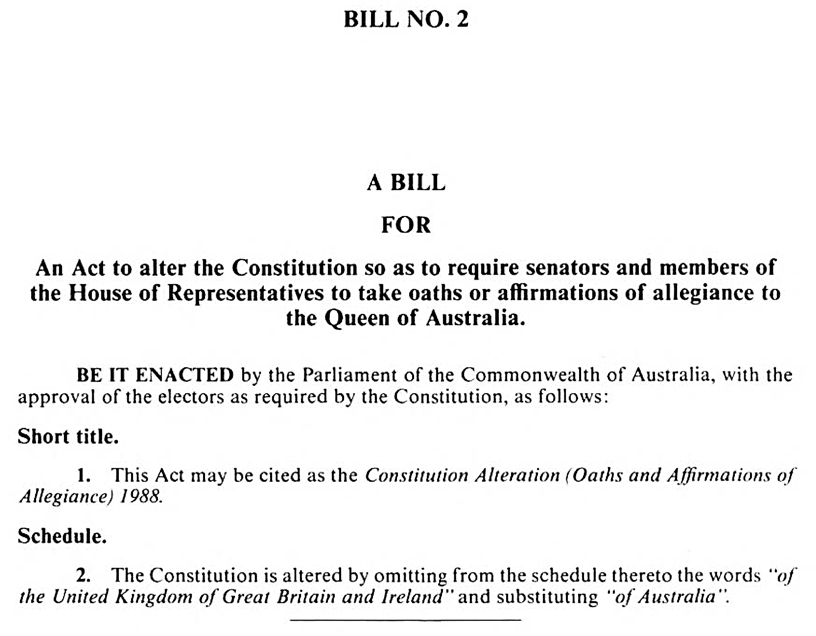Extracts from that report SelectExtractsConstitutionalReport1988 (7 page pdf by Darren D, Constitutional Watch)
Notice of Extracts – Queen and Crown
First & Final Constitutional Commission Reports 1988.
Darren Dickson
• Le contrat fait la loi. The contract makes the law.
• Quod populus postremum jussit, id just ratum esto. What the people have last enacted, let that be the established law.
• Verba intentioni, non e contra, debent inservire. Words ought to be made subservient to the intent, not contrary to it. 8 Co. 94.
• Quicquid in excessu actum est, lege prohibitur. Whatever is done in excess is prohibited by law. 2 Co. Inst. 107.
Contents
1. Introduction.
2. Terms of Reference.
3. Commonwealth of Australia Constitution Act 1900
4. First Report – Removal of the Crown
5. Commission Background.
6. Stages of Commissions for constitutional review.
7. Intention to Change the First Law and Schedule.
8. Intention to recognise the Queen of Australia within the Commonwealth.
9. Prime Minister.
10. Queen’s ministers of State.
11. Bill No. 1 to recognise the Queen of Australia.
12. Bill No. 2 for Oaths and Affirmations to the Queen of Australia.
13. Bill No. 7 for Citizenship.
14. Conclusion.
15. Declaration.
1. Introduction.
This summary has been prepared by scrutiny of an official public record, commissioned by the Australian government and published in 1988. The summary provides evidence for insight into activities having been promoted to replace Queen Elizabeth II, as Queen of United Kingdom, from application as the sovereign within the Commonwealth as expressed in the foundation Act for the Commonwealth of Australia, established 1900.
The revision of The Constitution had been prepared by the Constitutional Commission consisting of Sir Maurice Byers, CBE, QC Chairman, Professor Enid Campbell OBE, Hon Rupert Hamer KCMG, Hon E.G. Whitlam AC, QC & Professor Leslie Zines and delivered to the Attorney Generals Department on June 30th 1988.
The summary has focused on the constitutional expressions for the application of the Crown and monarch, analysing the means and manner, in which an ‘alternate’ Crown and office of monarch had been introduced to supersede that as the Commonwealth of Australia Constitution Act may recognise.
2. Terms of Reference.
This summary focuses on specific terms of reference made by the Commission, on the Crown, Monarch and subjects in light of the current written law.
3. Commonwealth of Australia Constitution Act 1900
The current expression identifies the Crown and Queen for application and command:
COMMONWEALTH OF AUSTRALIA CONSTITUTION ACT
– PREAMBLE
WHEREAS the people of New South Wales, Victoria, South Australia, Queensland, and Tasmania, humbly relying on the blessing of Almighty God, have agreed to unite in one indissoluble Federal Commonwealth under the Crown of the United Kingdom of Great Britain and Ireland, and under the Constitution hereby established:
– CLAUSE 2
Act to extend to the Queen’s successors
The provisions of this Act referring to the Queen shall extend to Her Majesty’s heirs and successors in the sovereignty of the United Kingdom.
– CLAUSE 5
Operation of the Constitution and laws [see Note 3]
This Act, and all laws made by the Parliament of the Commonwealth under the Constitution, shall be binding on the courts, judges, and people of every State and of every part of the Commonwealth, notwithstanding anything in the laws of any State;
4. First Report Identifies the Crown’s Removal
Leading extracts on the identity of the Crown from the First Report of the Constitutional Commission, at pages 109 & 110:
The Crown, therefore, was one Imperial Crown. That is no longer the case.
There was in law and in fact no distinct Monarch of Australia, Canada, New Zealand, etc. There was just the one and indivisible sovereign of all parts of the Queen’s dominions.
We consider that covering clause 2 gives the impression that our Monarch must be chosen according to the law of another country and, further, it can mislead a person to the view that the institution of Monarchy in Australia is not an entirely separate institution from the Monarchy in the United Kingdom. It can hardly be said, therefore, that covering clause 2 reflects Australia’s independent status. The reverse is the case.
We recommend, accordingly, that:
(a) in covering clause 2 the words ‘the United Kingdom’ be omitted and the word ‘Australia’ be substituted; and
(b) in the Note to the Schedule to the Constitution the words ‘the United Kingdom of Great Britain and Ireland’ be omitted and the word ‘Australia’ be substituted.
5. Commission Background.
A commission for this report was established by executive decision of the Federal government, at page 33:

6. Stages of Commissions for constitutional review
• 1929 – Royal Commission by letters patent,
• 1956 – Joint Parliamentary Committee by resolutions of two Houses of the Federal Parliament,
• 1973 – Australian Constitutional Convention by initiative of Victorian Parliament, at page 37:

7. Intention to Change the First Law and Schedule
Clause 2 – The Commission promoted the change of the Crown and effect a change in the identity of the sovereign, in alteration of the second clause and schedule, by removing reference to ‘United Kingdom’ and replacing it with ‘Australia’, at page 2:

Recommendation for alteration of the second clause to recognise the Queen of Australia, at page 1055:
![]()
8. Intention to recognise the Queen of Australia within the Commonwealth.
The commission takes the view of ‘Australia’ being a constitutional monarchy in which reference of ‘colonial’ is intended in the eighth clause.
The report makes note of the Commission’s position in the identity of the Queen and as the head of State, to be the Queen of Australia, at page 12:

9. Prime Minister.
The report promotes the position of Prime Minister, to be constitutionally recognised, for inclusion by a new sub-provision to the Constitution within s62, at page 13:

10. Queen’s ministers of State.
The report promotes Ministerial advice to Her Majesty, as from Australian Ministers, for constitutional expression by inserting to the Constitution within section 64, at page 13:

11. Bill No. 1 – for recognition of the Queen of Australia.
Clause 2 of the Constitution Act provides the provisions within the Commonwealth Constitution exclusively extend to the heirs and successors of Queen Victoria in the sovereignty of the United Kingdom. The Commission Report of 1988 makes recommends to substitute Queen Elizabeth II with the Queen of Australia. Bill No. 1, at page 977:

12. Bill No. 2 – Oaths and Affirmations to Queen of Australia
The second Bill recommended by the Commission seeks Constitutional recognition of the Queen of Australia so as to provide validation for senators and members of the House of Representatives to take oaths or affirmations of allegiance as none currently exists. Bill No. 2, at page 978:

13. Citizenship.
Bill No. 7 is to promote constitutional recognition of powers for ‘nationality’ and ‘citizenship’ by referendum, at page 999:

Recognition sought for ‘nationality’ and ‘citizenship’, at page 4:

14. Conclusion.
The constitutional powers, vested in the Queen, may be regarded, in light of the promotion for the alteration of the Constitution to recognise the Queen of Australia, as not currently available for parliamentary law-making exercise, or for judicial exercise by the courts.
It is apparent that the list of powers sought presumes, for various reasons, the Federal Parliament has been operating unconstitutionally and the commission sought constitutional changes to validate the operations of the Federal Parliament within new constitutional parameters as advanced by the Constitutional Commission.
The proposed Bills, above, is evidence of strong presumption that the use of the Queen of Australia is outside the bounds of the foundation law.
The Act attributed to create the Queen of Australia, the Royal Style and Titles Act 1973 is acknowledged, by the commission, not to be included for power within the Constitution.
There is no power available to create an office, of ‘Queen’, for adoption by the monarch and such title fails in substance to meet the qualification of an ‘heir and successor’ to Queen Victoria. There is no evidence that shows a provision exists for allegiance to an alternate
Queen outside the Constitution Act.
The same discrepancies apply for Australia’s citizenship laws: Bill No. 7 is evidence to infer the Federal Parliament is without constitutional power to write laws for citizenship in contradistinction to British subjects.
It is noted that Australia’s citizenship laws are not recognised by the Commonwealth of Australia Constitution Act nor is the allegiance to an alternate Queen, the presumption being that the constitutions of the Commonwealth, and those of the States, recognise the people within the Commonwealth enjoy British citizenship, and the protections thereof.
Declaration.
I declare this summary to be an accurate summary, on the status of the Queen and the people of the Commonwealth, from the above referenced report, as I am able to understand the report.
Prudentur agit qui praecepto legis obtemperat
He acts prudently who obeys the commands of the law. 5 Co. 49.
by Darren Dickson, Constitutional Watch
